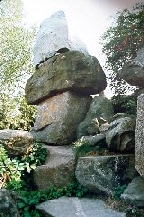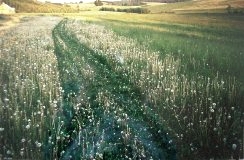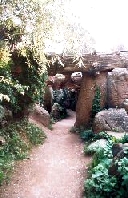|
 A Shape
A Shape
Revolving
Forever
Vytautas V Landsbergis:
Vilius Orvidas
Victoria Roberts
Sculptor of stone and wood, farmer and sometime monk, Vilius Orvidas is a cultural symbol in the documentary by filmmaker Vytautas V Landsbergis. Still, Ovidas the artist, like his sculpted work, is not a monolith. Even as this account of his life and work creates a cultural terrain, it is uneven, stony ground.
The film that bears his name, Vilius Orvidas (2001), provokes the central question of the auteur and the nature of creativity. The Lithuanian tradition in documentaries is very creative, adding its own aesthetic value to a subject. This film evidences an intricate editing job with the inclusion of works and interviews on Orvidas as well as interviews with the man himself.
The story of Vilius Orvidas and the family farm he embellished with his carvings in wood and stone is developed through layers of mediation, far from fly-on-the-wall, but engrossing in perspective.
In the first rank, Landsbergis uses filmmakers and other artists out of whose work this documentary was stitched in part. Leonidas Surgaila, the film's cameraman, appears intermittently to assimilate the material of others, who include Jonas Mekas, Lithuanian poet-filmmaker living in Manhattan; Audrius Stonys, whose documentary Antigravitacija (Antigravitation, 1995) was recently shown in London; and artist Henrikas Šablevičius. Surgaila has the final word with his announcement that he taped an interview with Orvidas three weeks before the artist died.
Another tenet of the film is that behind the artists, the forces of society, state and tradition continually shape art, attributing meaning, supporting it, repressing it, interpreting it. The Communist party-state, an arbiter of meaning for the greater part of the 20th century, appears to have undertaken interpretation of Orvidas's work, from the level of the local authorities and the Komsomol all the way up to the national leadership.
Orvidas notes (in Lithuanian, not Russian) "a new terror" from Yuri Andropov. Still, it was soldiers who brought him stones for his projects. When Mikhail Gorbachev visited the Orvidas farm in 1980, he conducted a sympathetic, almost indulgent, exchange with the young Orvidas:
"How did you harm the State?"
"I believe in God, and so does my father."
"That is a matter of opinion."
Despite this, Orvidas gives us a measure of the restriction on his art stemming from external interpretation, frequently disavowing his work and attributing it to his father to divert the harsh gaze of critics. The religious nature of some of his carvings, he says, "irritated the Soviet authorities' sensibilities." Filmmaker Mekas adds, "Lithuania doesn't take him seriously, either."
 Bestowing inspiration and attracting trouble to him in equal measure, God, for Orvidas, is an inalienable part of art. "You can do all 99 per cent right, and get one thing wrong, and it's all in vain," he says. Elsewhere, he attributes much of his inspiration to "subconsciousness." So strongly does Orvidas identify God as creator that his thoughts on art and creativity begin to reveal a fragmented concept of the artist. Christianity shows a parallel in the schism between Christ's divinity and mortal nature.
Mortality, too, intervenes in Orvidas's case. As his protégé Vladas recounts, Orvidas drops dead within an hour of being told by tourists that he has not created anything himself; he has simply taken credit for all of the work after his father's death.
Modelling
Orvidas's life reflects his relationship with God and his recognition of God's inspiration. Just as the filmmakers and artists come out to endorse him, in this film and in the others out of which this film is spliced and sewn, Orvidas maintained several significant fostering relationships. His father, a carver of tombstones, not only fostered the skill of carving, through which his son's creativity was visibly expressed, but also protected his son by accepting authorship of his work.
The Orvidas farm also offered sanctuary more than once. A Jewish-Russian friend, Leonid Bashanov, remembers it as one of his own two possible hiding-places and says he once saw there a refugee with no documents, yet "No one would betray him."

Orvidas helped others, citing his belief in an "obligation to save souls, [to] help everyone, whoever comes." His protégé, a former drug-addict, completes Orvidas's transition from son to father. "I was in jail for many years," Vladas says in an interview, "and when I got out, I couldn't please anyone, not the government, not my father..." Even the dean of Kaunas called the police on him before Orvidas took him in.
Ties of parenthood are not, however, an automatic extension of this creative, nurturing impulse; Orvidas's mother presents a very different perspective, complaining, "I was not happy with him and always said so. Such a fuss, disorder! He's very disorganised." Fortunately, Orvidas had spiritual kin in his girlfriend, Maria (who later became a nun), to stand Mary against his mother's Martha (Morta Orvidiene).
Yet another form of kinship and inspiration complicates the portrayal of Orvidas as an artist: tradition. Leonid Bashanov comments that Orvidas had a deep sense of "Catholicism and paganism," and knew pop art as well. Indeed, if anyone looks around Lithuania, or even on one of the Web sites dedicated to Lithuanian culture and folk art, the materials (stone and wood) and subject matter (crosses, Christs, etc) look very familiar.
There are totem poles and temples, faces carved with an almost Palaeolithic simplicity, designs made in colour. Some crosses sprout extra arms, in the "sunburst" or "snake" style, which ethnographers attribute to a peculiarly Lithuanian merging of paganism with Catholicism. Not only is this artist close to anonymous artisans of the past, "his" traditions are also ambiguous and mixed.
Modern gloss
Amid this attention to tradition, there is a great deal of adaptation and innovation; as already discussed, the documentary tradition interprets for the subject matter and the artist. In the same way, style differentiates Orvidas's work from blind—and therefore anonymous—reproduction of patterns. Yet, in a medium that is strictly a view of another medium, there is room for creativity, editing and re-application of borrowed patterns.
Orvidas's material, mute except for his theories, is adapted for film in places by the addition of music on a wooden xylophone, similar to Saint-Saëns's Le Carnaval des Animaux (1886), in which skeletons are played in this way. Orvidas' turning stones into faces and bodies certainly supports this interpretation. Also, by adding time, which the medium of film makes possible, a new setting is made for the art of another. In this film, the sun sets—or sits—on the summits of some of Orvidas's stone creations. Creativity reproduces itself, this film seems to be saying. Šablevičius recalls being told that he "wouldn't be able to resist the temptation not to film."
One of the late sequences of images of the film comprises a slowly rotating aerial view of the Orvidas farm, revealed to form a triangle. The inclusion of such an image, with the sacred organ music accompanying it, recalls Stonys's Antigravitacija, but also reaffirms Orvidas's sense of God, the Trinity, a shape which can revolve forever without offering an end.
A symbol in itself
There is perhaps an unstated agenda to this sampling which, nevertheless, is powerfully felt: a definition and elaboration of a uniquely Lithuanian cultural space, an affirmation of a Lithuanian nation. The film is a result and reminder of the country's strong documentary tradition. It also embodies Lithuanian Catholicism, strongly influenced by pagan traditions.
Although it is easy to attribute a son's work to his father, the perceived paternal motivation of Orvidas's inspiration must make us take into account that the filmmaker's father is Professor Vytautas Landsbergis, one of the most high-profile agitators for Lithuania's independence and nationhood within Sajudis and a musician specialised in the work of the highly-promoted Lithuanian composer M K Čiurlionis.
This film was produced with the sponsorship of the Lithuanian Ministry of Culture, under the patronage of the elder Landsbergis. Vilius Orvidas may be only one Lithuanian artist, but this account of his life and work deliberately showcases a nation.
Victoria Roberts, 25 June 2001
The UK premiere of the film was screened at the Horse Hospital, Colonnade, London. It was supported by the Lithuanian Embassy in London.
Moving on:
Sources:
The Baltic Art Network
Art Lithuania
|
|







